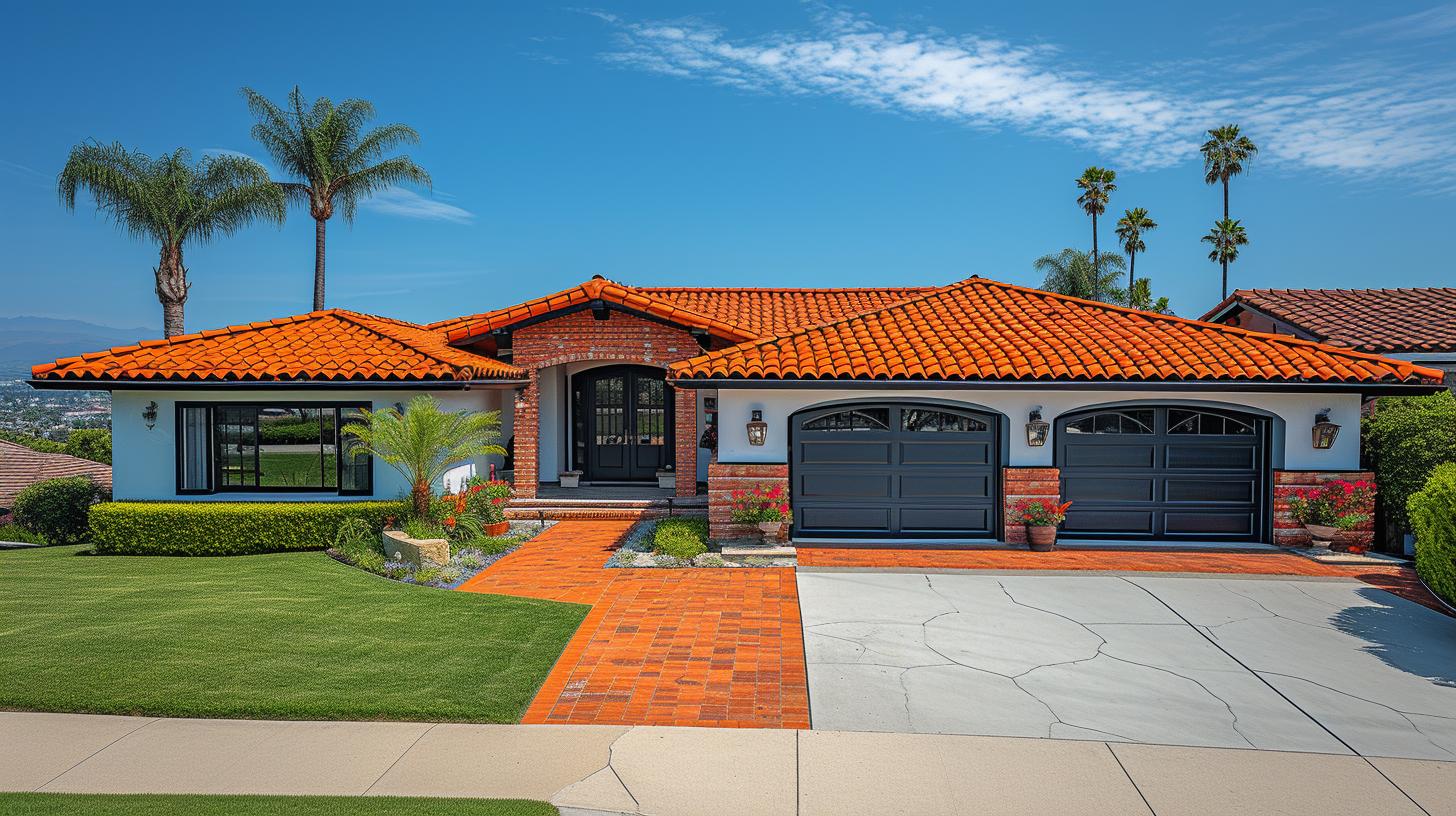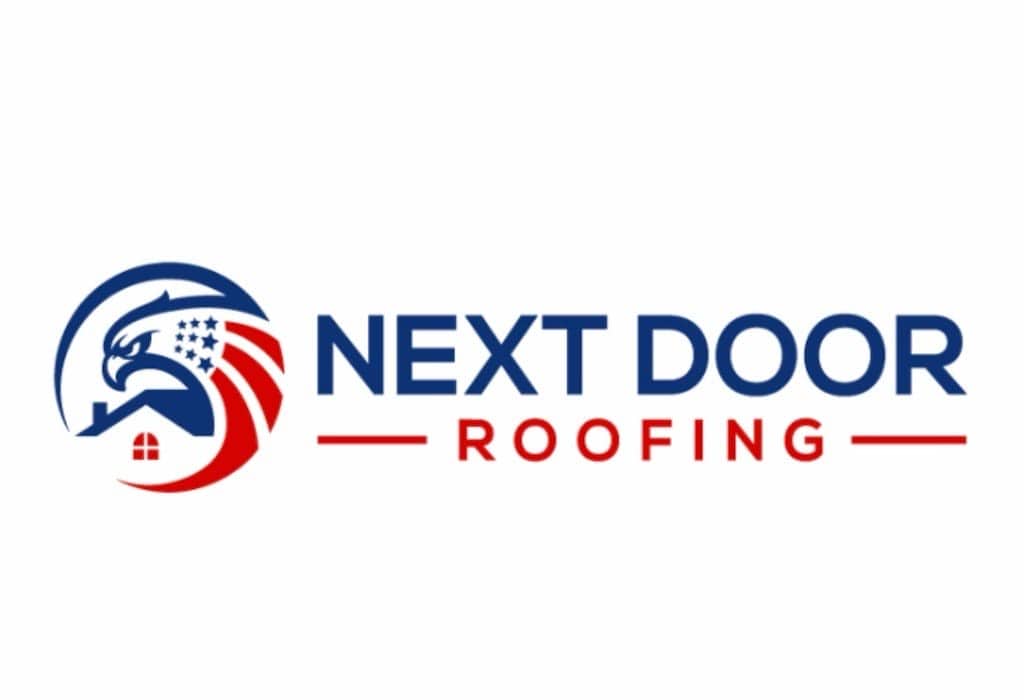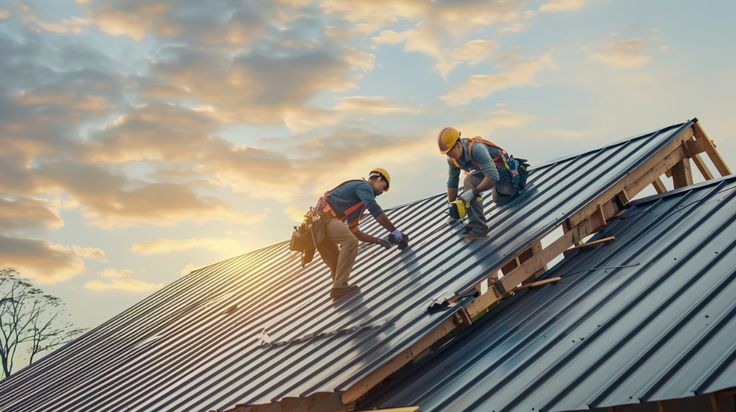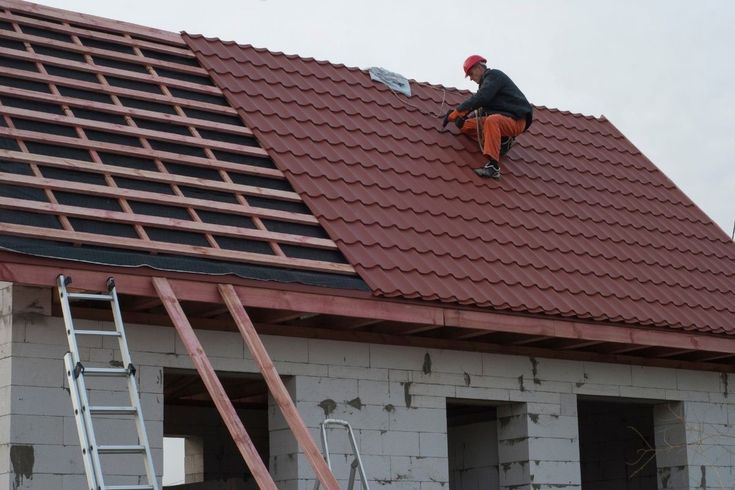When undertaking the journey of selecting the perfect covering for your home, a reliable roofing material guide becomes an indispensable tool. Right Roofing Material for Your Property Within this realm, Next Door Roofing stands as a beacon of knowledge and experience, ready to illuminate the path to making an informed decision for your property’s most crucial protective layer. With years of dedicated service in the industry, this company embodies the wisdom gained from countless installations and repairs-wisdom it is now poised to share.
Choosing the right roofing material is about more than just aesthetics; it’s about safeguarding your home against the elements while ensuring that your investment is sound both functionally and financially. Whether grappling with tumultuous weather patterns or seeking that sublime architectural accent, homeowners face a myriad of options-a testament to why expert guidance is invaluable.
This guide by Next Door Roofing has been carefully crafted to distill their extensive expertise into clear, actionable advice that demystifies the selection process.
As you delve into what follows, you’ll find comprehensive insights on everything from fundamental material properties to nuanced considerations like climatic suitability and curb appeal. Each section builds on Next Door Roofing’s deep understanding of how different materials perform in real-world scenarios; offering homeowners like you a detailed view of your options through their experienced lens. With this guide at your side, confidently navigating the complexities of roofing materials becomes a considerably more manageable endeavor.
Understanding the Basics of Roofing Materials
Roofing materials are the protective layers that sit on top of your property’s structure, providing a first line of defense against environmental elements like sun, rain, snow, and wind. The choice of roofing material is crucial as it directly affects the longevity and performance of your roof. Essentially, it can be thought of as the skin of your house; it needs to be durable enough to withstand wear and tear while complementing the overall appearance of your home.
When considering right roofing materials for their property, homeowners must take into account several key factors:
– Climate: Different materials perform better in certain climates. For example, metal roofs are excellent for snowy areas because snow slides off easily, while clay tiles are well-suited for hotter regions.
– Durability: Some materials like slate can last over a century with proper maintenance, whereas others might need replacement every 20 years or so.
– Aesthetics: The look of the roofing material should align with the architectural style of the property and personal preferences.
– Weight: It is essential to know if your home’s structure can support heavier options such as clay tiles or slate.
– Cost: Budget constraints play a significant role in decision-making; some options, though durable and attractive, may not be financially feasible.
It can be difficult to balance these factors. Practicality is essential for weatherproofing, but aesthetics are important too. A beautiful roof improves curb appeal and can transform your home’s appearance. Thus, combining functionality and aesthetics requires careful planning.
The roofing material guide compares materials based on these factors to simplify this decision. Understanding each material’s protection, aesthetics, and maintenance needs helps homeowners choose practical and stylish materials.
A Closer Look at Common Roofing Materials
When it comes to roofing, there are a variety of materials at a homeowner’s disposal, each with its unique characteristics and benefits. Quality roofing does more than just protect a home from the elements; it also contributes significantly to the home’s overall aesthetic and efficiency. Here’s a rundown of some common choices that homeowners might consider as part of their roofing material guide.
Asphalt Shingles: The Versatile Choice
Asphalt shingles are among the most popular roofing materials in North America due to their cost-effectiveness, ease of installation, and a wide range of styles and colors. Their composition typically includes a fiberglass mat coated with asphalt and finished with mineral granules. This fusion creates a water-resistant barrier capable of enduring various weather conditions.

Generally affordable, these shingles can last anywhere from 15 to 30 years depending on quality and maintenance regime. However, they’re not as durable as some other options and can be prone to damage in extreme weather conditions.
Metal Roofing: Durable and Eco-Friendly
Metal roofing has gained popularity for its durability, longevity (often lasting 40-70 years), and energy efficiency. Available in steel, aluminum, copper, or zinc alloys, metal roofs are excellent at reflecting solar heat which can help reduce cooling costs during warmer months.
Although upfront costs can be higher compared to asphalt shingles or other choices, metal roofs may offer greater long-term savings due to their minimal maintenance needs and potential energy cost savings. Furthermore, many homeowners appreciate the modern appearance metal roofs provide along with their recyclable nature at the end of their lifespan.
Wood Shakes and Shingles: Natural Beauty
For those seeking a more rustic aesthetic appeal for their homes, wood shakes or shingles are prized for their natural beauty and traditional look. Typically made from cedar or redwood trees that resist rot naturally, these materials age to an attractive silvery color over time.
Wood shakes are hand-cut leading them to have a rougher texture while wood shingles are machine-cut for a more uniform appearance. These wooden options do require regular maintenance including treatments for fire-resistance unless pre-treated varieties are chosen; but when well-cared-for they can last up 30 years or longer.
Clay Tiles: Timeless Elegance
If you’re opting for an elegant Mediterranean or Spanish style property then clay tiles could be your preferred option. They’re known for surviving decades – often over half a century – making them one of the most durable materials available today. Great in hot climates due to their ability to withstand high temperatures without deteriorating as quickly as others might under intense UV exposure; they come at an increased weight which may need extra structural support beneath them.
Each material offers different advantages in terms of visual appeal and functional performance – all important considerations reflected within any comprehensive roofing material guide aimed at helping homeowners navigate towards the best choice for their unique property needs.
The Roofing Material Guide
When embarking on a roofing project, it’s essential to have accurate and comprehensive information readily available. This ensures that you select the most suitable material for your home or building. To aid in this decision-making process, a roofing material guide provides a detailed comparison of various options by assessing critical attributes. Let’s delve deeper into how such a guide can serve as an invaluable resource.
At the heart of any roofing material guide is the comparative analysis of features from various materials. A well-crafted guide will break down each material’s characteristics, including durability, cost-effectiveness, maintenance requirements, aesthetic value, and suitability for different climates and conditions. For instance, while metal roofing may offer superior longevity and fire resistance, its higher initial cost might not fit every budget.
On the other hand, asphalt shingles could give a more balanced solution between affordability and performance. Individuals can refer to this collated data to weigh their options against personal criteria such as budget constraints or desired architectural style.
| Material | Fire Resistance | Impact Resistance | Average Lifespan | Cost (Per Sq Ft) |
|---|---|---|---|---|
| Metal | High | High | 40-70 years | $7-$12 |
| Asphalt Shingle | Moderate | Moderate | 15-30 years | $3-$5 |
Other considerations outlined in the roofing material guide may include warranty offerings that reflect the confidence manufacturers have in their products’ longevity and performance. These warranties are crucial as they can alleviate concerns about potential defects or premature degradation. Additionally, environmental impact assessments add another layer of consideration for eco-conscious homeowners looking to reduce their carbon footprint with sustainable options like green roofs or recycled materials.
In summary, leveraging this comprehensive right roofing material guide ensures that homeowners are armed with extensive knowledge allowing informed comparisons across multiple dimensions-functionality meeting visual preferences-all tailored to unique property needs and personal values.
Case Studies
With years of experience under their tool belts, the experts at Next Door Roofing have been part of numerous success stories where the right roofing material led to both aesthetic and functional triumph. By delving into detailed case studies, homeowners can gain insight into the roofing selection process and how particular materials can enhance their property’s endurance against nature’s elements while complementing its visual appeal.

Reviving a Historical Home With Slate
One notable project involves the renovation of a historical home whose authenticity was paramount to maintaining its character. The homeowners wanted a long-lasting solution to preserve the house’s heritage. After consultation, slate choose for its timeless elegance and durability.
Slate is known among roofing options for resisting severe weather conditions and fire, which was essential given the home’s age and design specifications. Over several years post-installation, not only has the slate roof upheld its virtues but it has also increased the property’s value and curb appeal significantly.
Modern Eco-Friendly Transformation With Metal Roofing
Another case study showcases a modern family’s desire to transform their home into an eco-friendly dwelling. Energy efficiency was at the forefront of their priorities, along with minimal maintenance requirements.
They opted for metal roofing, captivated by its reflective properties that reduce cooling costs in summer months and its recyclability at end-of-life. The installation resulted in lower utility bills, a drastic decrease in environmental impact through sustainable practices, and an aesthetically pleasing contemporary look that met all community standards.
Weather-Resistant Solutions in Storm-Prone Areas
The power of choosing an apt right roofing material becomes evident in regions prone to extreme weather events like hurricanes or frequent hailstorms. One such instance involved selecting a roofing system for a coastal property frequently exposed to high winds and rainstorms. The goal was enhance protection without compromising on style.
Architectural-grade asphalt shingles were used because they could withstand 130 mph winds and many styles that fit the seaside aesthetic. The durability test came soon after installation when a major hurricane struck; remarkably, while neighboring properties suffered significant damage, this carefully selected roof stood strong.
These examples are just glimpses into how Next Door Roofing has helped customers navigate through complex decisions using their comprehensive roofing material guide as well as professional expertise – leading not only to stunning results but also offering peace of mind knowing their selections can endure whatever Mother Nature throws their way.
Expert Tips From Next Door Roofing on Finalizing Your Choice
Choosing the right roofing material for your property is not just a matter of personal preference but also one of functionality and longevity. Next Door Roofing brings years of expertise to the table, offering advice that accounts for all critical factors in making this decision. When you’ve gone through the right roofing material guide and have learned about the different options available, it’s crucial to narrow down choices by considering specific elements unique to your property and circumstances.
First and foremost, assess the architectural style of your home. Certain materials complement particular designs more effectively than others. For instance:
- Homes with a Spanish or Mediterranean design often pair well with clay tiles.
- Colonial-style homes may benefit from the traditional look of slate or wood shakes.
- Modern or contemporary houses can achieve a sleek aesthetic with metal roofing options.
Beyond aesthetics, reflect on the practical aspects such as local climate conditions. Areas prone to severe weather conditions like hurricanes or hailstorms require materials known for resilience and impact resistance. In contrast, properties in hot climates might need roofing materials that reflect sunlight and provide better insulation. Consulting a local expert can make this part easier, as they well-versed in what works best for your area.
Finally, professional installation and manufacturer instructions are crucial. These technicalities greatly affect roof performance and lifespan. Poor installation can cause premature failures or void warranties even with high-quality materials.
Thus, hire licensed contractors who are knowledgeable about your chosen material. They will professionally install it and give you maintenance advice to keep it in good condition. Remember that getting a new roof is an investment in your home’s future, so these extra steps can maximise it.
Conclusion
After delving into the complexities of roofing materials, ranging from the basics to a nuanced comparative analysis, we hope this guide has illuminated the pathway to making an educated choice for your property. Choosing the right roofing material is crucial not just for aesthetic harmony but also for ensuring lasting protection and financial prudence.

The insights shared here by Next Door Roofing aim to arm you with knowledge so you can approach this decision with confidence. Whether considering the traditional charm of wood shakes or the modern resilience of metal roofing, it’s vital to weigh each factor carefully.
Next Door Roofing’s expertise does not end with this roofing material guide; their seasoned professionals are always ready to assist you further. They understand that every property is unique, requiring a tailored solution – one that honors your personal taste, aligns with local climate demands, and respects your budget constraints.
Consultations with Next Door Roofing experts can provide you clarity and guidance like no other resource can. They will help bridge the gap between what’s on paper and what’s practical by discussing options in the context of your specific situation.
Finally, remember that selecting a suitable roofing material is an investment in your property’s future. It enhances curb appeal, surety against weather elements, and directly influences resale value.
By involving firms like Next Door Roofing in your journey toward refurbishing or establishing your roof, you ensure that expert craftsmanship complements top-notch materials – setting a solid foundation for long-term satisfaction and peace of mind under your newly chosen roof. So take that step today towards safeguarding and beautifying tomorrow – secure in the knowledge that with the right guidance and materials, your home will stand both stylishly and sturdily for years to come.
Frequently Asked Questions
What Are the Top 5 Roofing Materials?
The top five roofing materials frequently used in the construction industry include asphalt shingles, metal roofing, wooden shingles or shakes, clay or concrete tiles, and slate. Asphalt shingles are prize for their cost-effectiveness and ease of installation. Metal roofs are durable and offer a long lifespan.
Wood shingles offer a natural aesthetic but require more maintenance. Clay or concrete tiles are popular in areas with hot weather and can also last a very long time while offering distinctive style options. Slate roofing is known for its premium appearance as well as its longevity and durability.
What Material Should I Use for My Roof?
The material you should use for your roof depends on several factors including climate, budget, aesthetic preference, and the structural capacity of your home. Asphalt shingles may be chosen if you’re looking for affordability and ease of installation whereas metal roofing could be a better option if durability and longevity are of higher priority to you.
In regions with extreme weather conditions, materials like slate or clay tiles might recommend due to their ability to withstand such environments while providing a unique look.
Which Right Roofing Material Lasts the Longest?
Slate is arguably the roofing material that lasts the longest; it can endure for over a century if properly maintained. This durability comes from slate’s natural stone composition which makes it incredibly resistant to harsh weather conditions as well as fireproof.
While it carries higher upfront costs compared to other materials, its longevity can make it cost-effective over time provided that the structure of the building can support its weight.
What Is the Cheapest Longest Lasting Roof?
Among the cheapest yet long-lasting roofs is metal roofing when considering lifecycle costs. Though initially more expensive than asphalt shingles another affordable option metal roofs boast impressive durability with lifespans often exceeding 50 years which means less frequent replacements compared to cheaper materials that need more regular renewing.
What Is the Longest Lasting Shingle?
When evaluating longevity among shingle types, architectural (or dimensional) asphalt shingles stand out because they have a longer lifespan than three-tab asphalt shingles their more basic counterpart—and are better at resisting wind uplift due to their contoured design that lends additional strength.
What Is the Least Expensive Roof Type?
The least expensive roof type typically is one using three-tab asphalt shingles given their low material cost and straightforward installation requirements making them highly accessible for many homeowners with limited budgets seeking immediate roofing solutions without frills.
What Is the Most Cost Effective Roof Material?
When looking at cost-effectiveness, asphalt shingles are usually thought to the best option. This is because they don’t cost much to install and last a long time, which is good for most home needs. This means that they are a good investment, especially if you keep them in good shape.
What Is the Most Expensive Roof Material?
The most expensive roof material on the market is genuine slate due to its superior durability and timeless elegance which commands premium pricing additionally legitimate installation necessitates skilled laborers courtly conversant with handling such intricate materials ultimately raising overall project expenditures notably.





